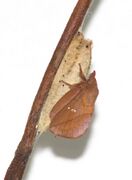Biology:Euthrix potatoria
| Drinker | |
|---|---|

| |
| Euthrix potatoria. Male | |

| |
| Female | |
| Scientific classification | |
| Kingdom: | |
| Phylum: | |
| Class: | |
| Order: | |
| Family: | |
| Genus: | |
| Species: | E. potatoria
|
| Binomial name | |
| Euthrix potatoria | |
| Synonyms | |
| |
Euthrix potatoria, the drinker, is an orange-brown moth of the family Lasiocampidae.[1]
The species' common and scientific names derive from the larva's supposed drinking of drops of dew.[2]
Name
The scientific name Euthryx potatoria was given to this moth by Carl Linnaeus in 1758. In choosing the name potatoria ‘drinker-like’, he was inspired by the Dutch entomologist Johannes Goedaert, who had called the animal dronckaerdt ‘drunkard’ “because it is very much inclined to drinking”.[3] This remark refers to the moth's habit of repeatedly plunging its head into the water.[4] The English name drinker (moth) also refers to Goedaert's analogy.
Subspecies
Subspecies include:[1]
- Euthrix potatoria mikado Bryk
- Euthrix potatoria potatoria (Linnaeus, 1758)
Distribution and habitat
This species can be found in Europe.[5] The species is fairly common in the southern half of Britain.[citation needed] In Scotland, it is common in the west but not in the east of the country.[6] It is most frequently found in marshy places, fens and riversides but may also be seen in drier, grassy terrain.[7][8]
Status
In a recent survey to determine the status of all macro moths in Britain this species was classified as common.
Description
Imago
The imago has a wingspan of 45–65 mm. The yellowish females are slightly larger than the orange-brown male but both sexes usually show the two distinctive white spots on the forewing.[8] Females have slightly serrated antennae, while male have deeply combed antennae.[9]
Larvae and pupae
The fully grown larva is about 6 cm long, hairy, striped and spotted, with distinctive tufts fore and aft. Larvae hibernate while young and resume feeding in the spring, pupating in a cocoon during the summer.[7]
Biology
This nocturnal moth flies from June to August depending on the location. Males especially are attracted to light.[7][8] The females lay their eggs in small clusters, mainly on the stem of grasses or reeds.[9] The larvae feed on various grasses and reeds (Alopecurus, Deschampsia, Dactylis, Elytrigia, Carex, Luzula and other Gramineae).[10]
Gallery
References
- ↑ 1.0 1.1 Biolib
- ↑ "The Drinker Euthrix potatoria". UK Moths. https://ukmoths.org.uk/show.php?id=2149. Retrieved 18 June 2014.
- ↑ Goedaert, J. (1660), Metamorphosis naturalis. Middelburgh: Jaques Fierens (p. 47).
- ↑ Beelen, H., & Van der Sijs, N. (2018). Natneus, molenaar, hypocriet. Insectennamen uit de zeventiende eeuw. Onze Taal, 2018(7/8), 26-27.
- ↑ Fauna europaea
- ↑ NMRS map
- ↑ 7.0 7.1 7.2 Ford, R.L.E. (1963). Larger British Moths. Frederick Warne.
- ↑ 8.0 8.1 8.2 UK Moths
- ↑ 9.0 9.1 Insight.com/drinker-moth-euthrix-potatoria-bf-1640/ Wildliifeinsight[yes|permanent dead link|dead link}}]
- ↑ Paolo Mazzei, Daniel Morel, Raniero Panfili Moths and Butterflies of Europe and North Africa
External links
| Wikimedia Commons has media related to Euthrix potatoria. |
Wikidata ☰ Q261060 entry
 |








